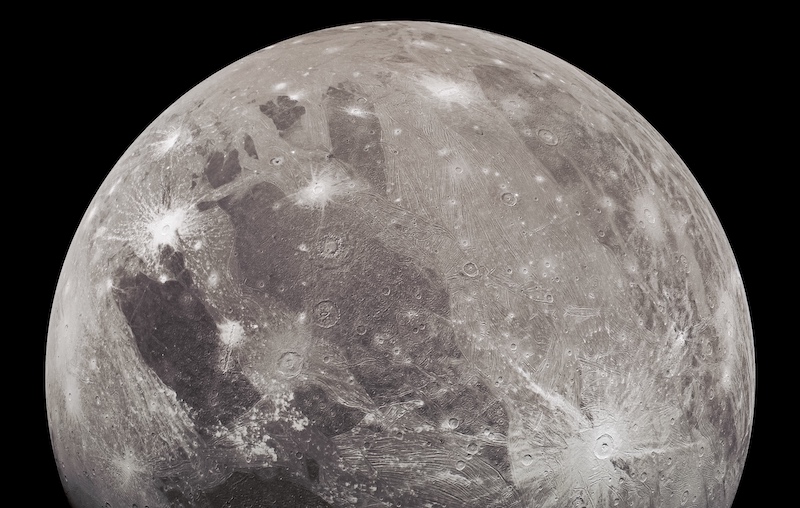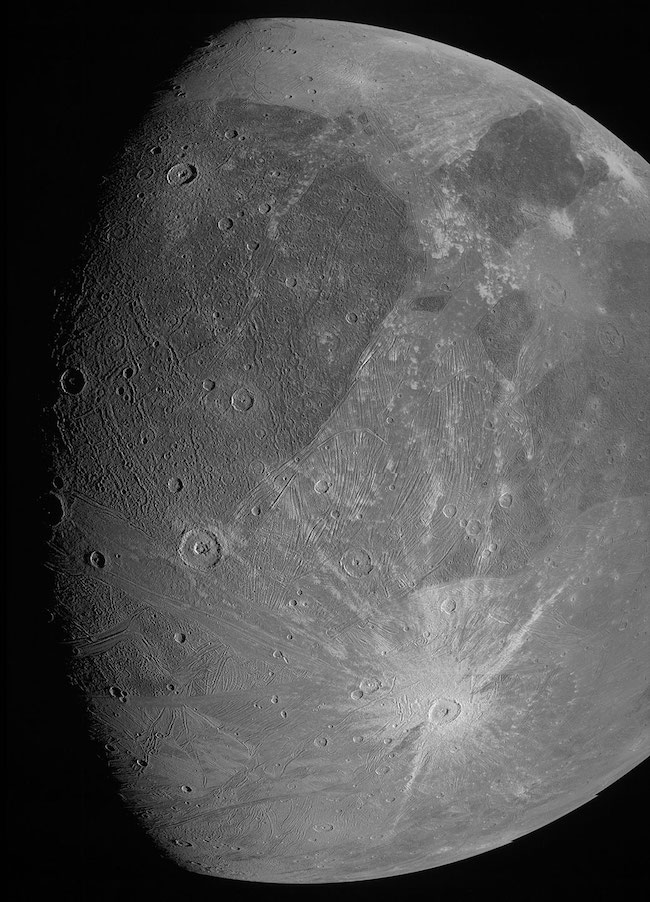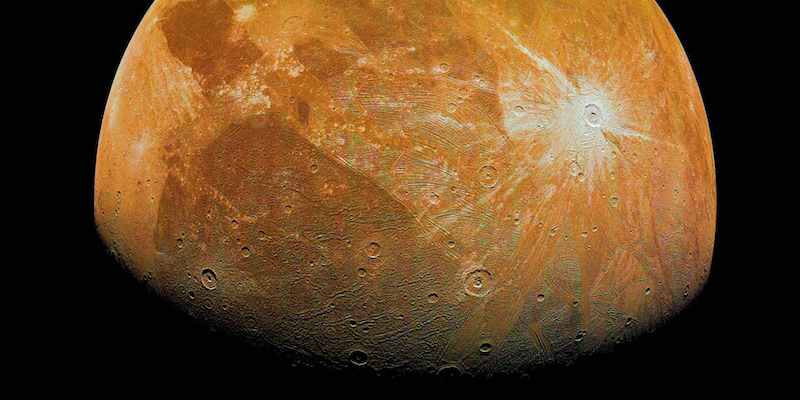
The last time we saw Jupiter’s largest moon Ganymede up close was over two decades ago. Now NASA has released new closeups of the moon, taken on June 7, 2021, by the Juno orbiter. The stunning images reveal Ganymede’s icy surface in striking detail. They show the moon’s craters, bright and dark terrain and long linear features that may be similar to tectonic faults on Earth.
First flyby of Ganymede in over 20 years
This is the closest that any spacecraft has come to the giant moon since the Galileo spacecraft’s close flyby on May 20, 2000. Juno flew past Ganymede on Monday, June 7, at 1:35 p.m. EDT (10:35 a.m. PDT). It came within 645 miles (1,038 km) of the surface at closest approach. Scott Bolton of the Southwest Research Institute (SwRI) and Juno Principal Investigator said in a statement:
This is the closest any spacecraft has come to this mammoth moon in a generation. We are going to take our time before we draw any scientific conclusions, but until then we can simply marvel at this celestial wonder.

New images of Ganymede and its icy surface
The images provide our first good glimpse of this mysterious world in over two decades. One image was taken by Juno’s JunoCam imager and the other is from the Stellar Reference Unit (SRU) star camera.
Juno was able to capture almost an entire side of Ganymede with JunoCam, with a resolution of 0.6 miles (1 km) per pixel. Right now most of the images are in black-and-white, but other pending photos will be in color.
The SRU camera looked at Ganymede’s dark side, illuminated only by dim sunlight reflecting off Jupiter. The resolution in that image is 0.37 to 0.56 miles (600 to 900 meters) per pixel. According to Heidi Becker, Juno’s radiation monitoring lead at JPL:
The conditions in which we collected the dark side image of Ganymede were ideal for a low-light camera like our Stellar Reference Unit. So this is a different part of the surface than seen by JunoCam in direct sunlight. It will be fun to see what the two teams can piece together.


Juno, Jupiter and Ganymede
Juno’s primary mission has been to study Jupiter itself, examining its clouds, storms, and deep interior. But the spacecraft is also well-equipped to look at some of its moons as well. As Bolton explained:
Juno carries a suite of sensitive instruments capable of seeing Ganymede in ways never before possible. By flying so close, we will bring the exploration of Ganymede into the 21st century, both complementing future missions with our unique sensors and helping prepare for the next generation of missions to the Jovian system: NASA’s Europa Clipper and ESA’s [European Space Agency’s] JUpiter ICy moons Explorer [JUICE] mission.
The probe also used other instruments to study Ganymede, including the Ultraviolet Spectrograph (UVS) and Jovian Infrared Auroral Mapper (JIRAM). The Microwave Radiometer (MWR) instrument can also better determine the composition and temperature of Ganymede’s water-ice crust.

Largest moon in the solar system
Ganymede is not only Jupiter’s largest moon, it is the largest natural satellite in the entire solar system. It is even larger than the planet Mercury. It is also the only moon to have its own magnetosphere. A magnetosphere is a bubble-shaped region of charged particle around a body such as a planet or moon.
Like Jupiter’s other large moons Callisto and Europa, Ganymede has an icy surface and outer ice shell. That surface features craters, unusual light and dark regions and long cracks similar to tectonic faults on Earth. These are evidence of active geology on the moon in the past, and perhaps still on-going. Bolton said:
Ganymede’s ice shell has some light and dark regions, suggesting that some areas may be pure ice while other areas contain dirty ice. MWR will provide the first in-depth investigation of how the composition and structure of the ice varies with depth, leading to a better understanding of how the ice shell forms and the ongoing processes that resurface the ice over time.
An ocean on Ganymede?
Ganymede has three main layers: a metallic iron core, a rocky mantle and an outer shell of ice about 500 miles (800 km) thick. In 2015, NASA’s Hubble Space Telescope also found evidence for a subsurface ocean of water on Ganymede. The ocean, beneath the ice crust, is estimated to be 60 miles (100 kilometers) deep, 10 times deeper than Earth’s oceans. John Grunsfeld, former associate administrator of NASA’s Science Mission Directorate, said:
This discovery marks a significant milestone, highlighting what only Hubble can accomplish. In its 25 years in orbit, Hubble has made many scientific discoveries in our own solar system. A deep ocean under the icy crust of Ganymede opens up further exciting possibilities for life beyond Earth.
If confirmed, Ganymede’s ocean would be one of several now known to exist on icy moons in the outer solar system. Europa and Enceladus are the two most well-known of these worlds. Could it be habitable? No one knows yet, until more data is obtained.
Juno will send back more images from the flyby over the coming days, so stay tuned! Raw images are available on the JunoCam website.
The spacecraft has been orbiting Jupiter since 2016, studying the giant planet’s deep atmosphere, clouds, storms, auroras and hidden interior. It also previously captured some beautiful images of active volcanoes on the moon Io.
Bottom line: NASA’s Juno spacecraft has sent back the first new closeup images of Jupiter’s largest moon Ganymede in over 20 years.











